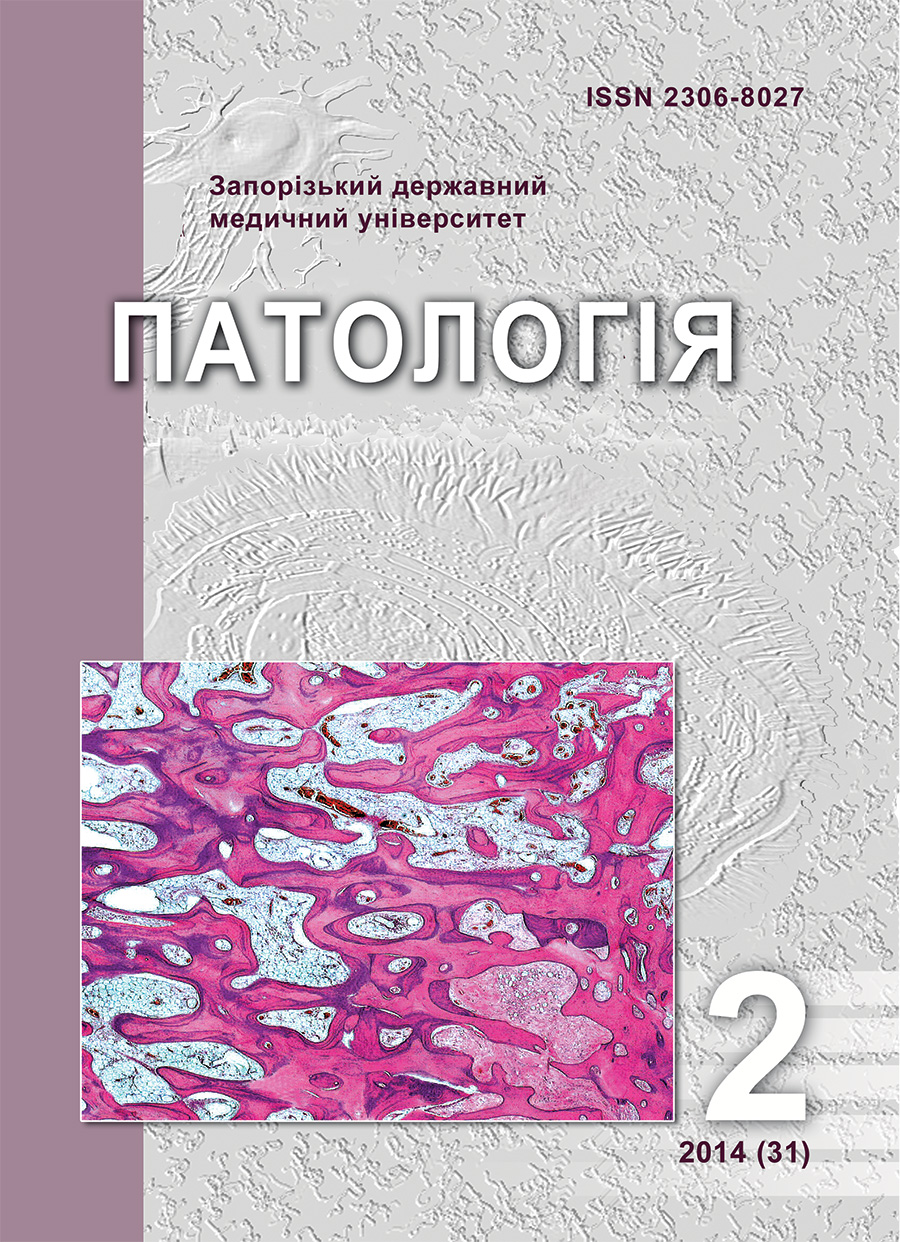Predictors of exercise-induced arrhythmias in early stages of treadmill test in hypertensive males
DOI:
https://doi.org/10.14739/2310-1237.2014.2.28563Keywords:
Arrhythmias, Hypertension, Heart Function TestsAbstract
Aim. Early exercise-induced cardiac arrhythmias may have an adverse prognostic value in patients with arterial hypertension. The aim of the study was to estimate the clinical and instrumental features of the cardiovascular system in hypertensive patients with early exercise-induced arrhythmias and to find the predictors of their manifestation.
Methods and results. We enrolled 249 hypertensive males who underwent treadmill test. A combination of supraventricular and ventricular extrasystoles was registrated most commonly at the first stage of the test. Patients with exercise-induced arrhythmias were characterized by increased target organs damage severity.
Conclusion. Independent predictors of early exercise-induced cardiac arrhythmia areReferences
Mancia, G., Fagard, R., Narkiewicz, K., Redуn, J., Zanchetti, & A., Bцhm, M. (2013). ESH/ESC Guidelines for the management of arterial hypertension: The Task Force for the management of arterial hypertension of the European Society of Hypertension (ESH) and of the European Society of Cardiology (ESC). Eur. Heart J., 34, 2159-2219. doi: 10.1097/01.hjh.0000431740.32696.cc.
Simpson, R. J., Cascio, W. E., Schreiner, P. J., Crow, R. S., Rautaharju, P. M., & Heiss, G. (2002). Prevalence of premature ventricular contractions in a population of African American and white men and women: the Atherosclerosis Risk in Communities (ARIC) study. Am. Heart J., 143, 535–540. doi:10.1067/mhj.2002.120298.
Vasan, R. S., Larson, M. G., Leip, E. P., Kannel, W. B., & Levy, D. (2001). Assessment of frequency of progression to hypertension in non-hypertension participants in the Framingam Heart Study: a cohort study. Lancet, 358 (9294), 1682–1686. doi:10.1016/S0140-6736(01)0671.
Morshedi-Meibodi, A., Evans, J. C., Levy, D., Larson, M. G., & Vasan, R. S. (2004) Clinical correlates and prognostic significance of exercise‐induced ventricular premature beats in the community: the Framingham Heart Study. Circulation, 109, 2417–2422. doi:10.1161/01.CIR.0000129762.41889.41.
Eckart, R. E., Field, M. E., Hruczkowski, T. W., Forman, D. E., Dorbala, S., Di Carli, M. F., et al. (2008). Association of electrocardiographic morphology of exercise-induced ventricular arrhythmia with mortality. Ann. Intern. Med., 149, 451–460. doi:10.7326/0003-4819-149-7-200810070-00005.
Dewey, F. E., Kapoor, J. R., Williams, R. S., Lipinski, M. J., Ashley, E. A., Hadley, D., et al. (2008). Ventricular arrhythmias during clinical treadmill testing and prognosis. Arch. Intern. Med., 168 (2), 225–234. doi: 10.1001/archinte.168.2.225.
Frolkis, J. P., Pothier, C. E., Blackstone, E. H., & Lauer, M. S. (2003). Frequent ventricular ectopy after exercise as a predictor of death. N. Engl. J. Med. 348, 781–790. doi: 10.1056/NEJMoa022353.
Kolesnik. M. Yu., & Sokolova, M. V. (2014). Prediktory vozniknovenija narushenij ritma serdca u bol'nyh arterial'noj gipertenziej vo vremja prob s fizicheskoj nagruzkoj [Predictors of cardiac arrhythmias in patients with arterial hypertension during exercise stress testing]. Georgean Medical News, 2(227), 37–42. [in Russian].
Nagueh, S. F., Appleton, C. P., Gillebert, T. C., Marino, P. N., Oh, J. K., Smiseth, O. A (2009). Recommendations for the evaluation of left ventricular diastolic function by echocardiography. Eur. J. Echocardiogr., 10, 165–193. doi: 10.1093/ejechocard/jep007.
Touboul, P. J., Hennerici, M. G., Meairs, S., Adams, H., Amarenco, P., Bornstein, N., et al. (2012). Mannheim Carotid Intima-Media Thickness and Plaque Consensus Cerebrovasc. Dis. 34 (4), 290–296. doi: 10.1159/000343145.
Beckerman, J., Wu, T., Jones, S., & Froelicher, V. F. (2005). Exercise test-induced arrhythmias. Prog. Cardiovasc. Dis., 47, 285–305. doi.org/10.1016/j.pcad.2005.02.011.
Jouven, X., Zureik, M., Desnos, M., Courbon, D., & Ducimetiere, P. (2000). Long-term outcome in asymptomatic men with exercise-induced premature ventricular depolarizations. N. Engl. J. Med., 343, 826–833. doi: 10.1056/nejm200009213431201.
Yiu, K-H., & Tse, H-F. (2008). Hypertension and cardiac arrhythmias: a review of the epidemiology, pathophysiology and clinical implications. Journal of Human Hypertension, 22, 380–388. doi: 10.1038/jhh.2008.10.
Sander, D., Kukla, C., Klingelhцfer, J., Winbeck, K., & Conrad, B. (2000). Relationship between circadian blood pressure patterns and progression of early carotid atherosclerosis: A 3-year follow-up study. Circulation, 102, 1536–1541. doi: 10.1161/01.cir.102.13.1536.
Ozawa, М., Tamura, K., Okano, Y., Matsushita, K., Ikeya, Y., Masuda, S., et al. (2009). Blood pressure variability as well as blood pressure level is important for left ventricular hypertrophy and brachial-ankle pulse wave velocity in hypertensives. Clinical and Experimental Hypertension, 31, 8, 669–679. doi: 10.3109/10641960903407033.
Schillaci, G., Bilo, G., Pucci, G., Laurent, S., Macquin-Mavier, I., Boutouyrie, P., et al. (2012). Relationship between short-term blood pressure variability and large-artery stiffness in human hypertension. Hypertension, 60, 369–377. doi: 10.1161/HYPERTENSIONAHA.112.197491.
Parati, G., & Schumacher, H. (2014). Blood pressure variability over 24 h: prognostic implications and treatment perspectives. An assessment using the smoothness index with telmisartan-amlodipine monotherapy and combination. Hypertension Research, 37, 187–193. doi:10.1038/hr.2013.145.
DeBacker, G., Jacobs, D., & Prineas, R. (1979). Ventricular premature contractions: a randomized non-drug intervention trial in normal men. Circulation, 59, 762–769. doi: 10.1161/01.CIR.59.4.762.
Downloads
How to Cite
Issue
Section
License
Authors retain copyright and grant the journal right of first publication with the work simultaneously licensed under a Creative Commons Attribution License that allows others to share the work with an acknowledgement of the work's authorship and initial publication in this journal.



